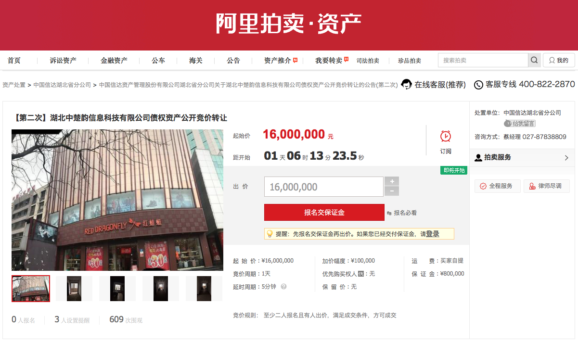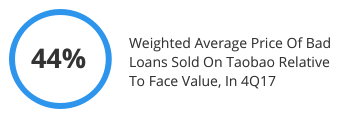- July 25, 2018
Returning to Its Roots: The Role of Taobao Auctions in Resolving Delinquent Loans
When bad loans were first auctioned on Taobao—Alibaba’s e-commerce platform—foreign observers were generally incredulous, chalking it up as the sort of Chinese-style financial innovation that would either not catch on or, if it did, would quickly flame out. More recently, when three Boeing 747s[1] and, separately, a skyscraper[2] were auctioned on Taobao after being seized from delinquent debtors, the media mostly dismissed the sale as the sort of quirky “only-in-China” stories that get filed at the bottom-of-the-news. While it may seem weird that bad loans and commercial aircraft should be sold over a retail platform not dissimilar to Amazon, that oddity belies the important role Taobao has assumed in helping financial institutions extract value from bad loans.
Alibaba has been a major driver of financial innovation in China in recent years, pushing aggressively into areas like money markets, payments systems, and consumer credit. Its auction business, however, represents something of a return to its roots. Taobao earned the moniker “the Ebay of China” soon after its launched in 2003 for its auction business,[3] but it eventually shifted away from auctions to selling consumer goods at fixed prices. Recently it has breathed life back into its auction business, building a thriving platform for competitive bidding on art works, second-hand cars, luxury watches and handbags, jewelry, antiques—and bad loans.
Taobao’s auction forum contributes to China’s NPL clean up in two ways. Firstly, it functions as a platform over which banks and asset management companies can auction bad loans, fulfilling a role not unlike that of financial asset exchanges (about which we wrote in great detail in May). Based on data from the fourth quarter of 2017, we found that Taobao was the single most active platform for NPL auctions, selling more bad loans by face value than the biggest of the financial asset exchanges, an amount comparable to about 35% of total NPLs auctioned by the 20 financial exchanges we tracked over the same period.
Screenshot of a Taobao NPL Auction Notice
Source: Taobao.
While that makes Taobao a major player in the evolving ecosystem of nonperforming loan (NPL) disposal, it plays an equally important role as a platform over which creditors can claw back their losses on delinquent loans by liquidating the collateral backing them. However, the significance of that role is far more difficult to quantify. This report will look at both roles and present our findings from data we collected on Taobao NPL auctions over the last three months of 2017.
NPL Auctions
Taobao is a relative newcomer to the NPL auction market. Whereas the Tianjin- and Beijing-based financial asset exchanges auctioned their first NPLs in 2010, Taobao only began in March 2015 when Cinda Asset Management Co. sold two loans over its platform. We collected data on every NPL auction conducted on Taobao between October and December in 2017 in order to compare the platform with the financial asset exchanges.[4] The key takeaways are as follows:
- From October to December 2017, 1,023 loans were posted for auction on Taobao compared with about 3,000 on the 20 financial asset exchanges we monitored.
- Over that period, the total face value of bad loans put up for auction on Taobao came to 33 billion yuan compared with 93 billion yuan on the combined financial asset exchanges.
- Tianjin Financial Assets Exchange posted 1,125 over the period, marginally more than Taobao. However, the face value of those loans was only 28 billion yuan. The second most active NPL exchange was the Shandong Financial Assets Exchange, which auctioned 464 bad loans with a face value of 19 billion yuan (see Figure 1). For more detailed data on the financial asset exchanges, see here.
Figure 1. First Among Equals
The face value of NPLs auctioned on Taobao compared with the top five financial asset exchanges.
Source: Data is based on Taobao auction notices from Oct-Dec 2017
The real value of the Taobao data, however, is not that Alibaba has become one of the biggest players in the NPL auction market. Rather, Taobao’s growing role reinforces the meaningful contribution auctions have made in the disposal of NPLs in a relatively short period of time. In the last quarter of 2017 alone, financial asset exchanges auctioned off more than 120 billion yuan worth of NPLs. That’s equivalent to about 7% of the 1.7 trillion yuan worth of outstanding commercial bank NPLs at the end of that year.[5] Auctions clearly don’t dominate bad loan disposals, but they’re also no longer negligible and are helping to change the nature of the market by reaching a wider group of would-be investors.
Taobao seems to serve a slightly different mix of clients when compared with the financial asset exchanges. Based on our survey, most of the bad loans—by number and face value—posted for auction on the exchanges were put up for sale by banks directly. In contrast, 82% of loan volume and 81% of loan value posted on Taobao were sold by asset management companies (AMCs), accounting for 27 billion yuan of the total. Of that amount, Cinda Asset Management—the second largest of China’s Big Four AMCs—accounted for 55% of loans by face value, and China Great Wall Asset Management accounted for 14%. Meanwhile, Industrial Bank—one of China’s mid-tier banks—accounted for 55% of the face value of all loans posted by banks (see Figure 2). Of course, given that our data is drawn from such a short period of time, there’s no way of telling whether the distribution of auctions between banks and AMCs is more broadly representative of Taobao’s client base.
Figure 2. Tool of Choice for Bad Banks
NPLs posted for auction to Taobao in the last quarter of 2017 were mainly from AMCs
Source: Data is based on Taobao auction notices from Oct-Dec 2017
Otherwise, the nature of the loans put for auction on Taobao were broadly similar to those posted on the exchanges. Only a small percentage were loans to state firms (15% on Taobao, compared with 10% on the exchanges), and most of the borrowers were either manufacturers, in real estate, or were wholesalers and retailers. However, Taobao differs from the financial asset exchanges in that each auction notice discloses significantly more information to the public, including detailed data about loan collateral, pictures of that collateral, a map showing where the borrower is located, and most importantly the price at which the loans are sold.
 We calculated that the weighted average price of NPLs sold on Taobao (based on a sample of 600 loans after excluding loans that were extreme outliers, loans that didn’t disclose their original face value, and loans that were passed in at auction) came to 44% of the loans’ face value. That broadly gels with Chinese media reports that the sale price of NPLs rose throughout 2017 from below 30% to end the year at around 40% of their face value.
We calculated that the weighted average price of NPLs sold on Taobao (based on a sample of 600 loans after excluding loans that were extreme outliers, loans that didn’t disclose their original face value, and loans that were passed in at auction) came to 44% of the loans’ face value. That broadly gels with Chinese media reports that the sale price of NPLs rose throughout 2017 from below 30% to end the year at around 40% of their face value.
Judicial Auctions
The other major role Taobao plays in NPL resolution is in collateral disposal. Most Chinese bank loans are backed by some form of collateral—typically real estate but can also involve cars, inventory, machinery, mining rights, and equity in companies. The ability of banks to manage their NPLs has a lot to do with the ease with which they can seize the collateral backing delinquent loans and then sell it at a price that allows them to recoup as much of their losses as possible. To do that, a creditor requires a court order acknowledging their claim over the collateral, a process that usually involves litigation.[6] Once the court acknowledges the claim it initiates a judicial auction in order to sell the assets. Those auctions primarily occur online, although that’s a relatively recent development.
In November 2016, the Supreme People’s Court published a list of five online platforms over which it would henceforth encourage courts to conduct their judicial auctions: JD.com (which, separately, also auctions NPLs albeit on a much smaller scale than Taobao), People’s Court Litigation Assets Network (人民法院诉讼资产网), Public Auction (公拍网), the China Association of Auctioneers website, and Taobao.[7] (Judicial auctions take place online in other countries as well, but in China they occur on popular retail platforms like Taobao and JD.com.)
In many parts of the country courts had already been migrating their judicial auctions online. Taobao first started conducting judicial auctions in 2012 after the president of the High People’s Court of Zhejiang Province—in which Alibaba is based—approached Alibaba founder Jack Ma about it.[8] Like most auctions before the digital age, judicial auctions in China previously took place at a physical location. Auctioneers hired for the occasion routinely charged a 5% commission, which was to be paid by the cash-strapped debtors who struggled to pay the commission and wanted a cheaper alternative.[9] And so, Alibaba agreed to host these auctions on Taobao for free.
The Supreme People’s Court decision to encourage lower level courts nationwide to move their auctions online was seemingly motivated by the desire to ensure greater transparency and fairness. Open-cry auctions conducted in person invariably resulted in a far smaller pool of buyers than an online auction would—and sometimes that was by design as it allowed insiders to pick up assets cheaply.[10 ] Online auctions have a higher rate of success than traditional consignment auctions[11] and generate higher bids. Still, to ensure a successful auction it’s generally advisable that creditors line up a buyer in advance.
Initially Taobao’s auction platform was used only by Zhejiang courts. Then in January 2014, Jiangsu province’s courts signed up too.[12] According to Taobao’s website, more than 3,500 courts from every province and municipality—a group that includes provincial high courts, intermediate courts, and specialty courts focusing on rail, customs, and maritime issues—have now signed up to use Taobao for administrative auctions,[13] up from around 2,000 in February 2017.[14] Over the course of Taobao’s five years of conducting judicial auctions, the courts had initiated a total of 430,000 auctions, raising 270 billion yuan, according to a February 2017 report.[15] Moreover, Taobao had saved court-ordered auctions 8.1 billion yuan in fees.[16]
Even though Taobao’s judicial auctions are a move toward more transparency, there is still much that’s unknown. For instance, there is no public data on the use of Taobao relative to the other exchanges, so we have no way of knowing just how much cash banks have raised from selling collateral on Taobao or any of the other platforms, or to what extent those sales have allowed banks to claw back what they’re owed. Moreover, there’s no way of tracking collateral sales on Taobao. Notices posted on Taobao don’t mention who the creditor is, only the court that initiated the auction. In addition, it’s difficult to sort through the type of assets being auctioned, since beyond delinquent loans the courts also use online auctions to sell off assets seized in criminal proceedings, notably including the ill-gotten gains of corrupt officials.[17] (Anecdotally, however, collateral sales seem to account for most judicial auctions, and Taobao seems to be the most actively used of the five platforms endorsed by the Supreme People’s Court.)
There are indications that the number of judicial auctions have increased over the past year, as have the funds raised from such auctions, coinciding with more active efforts by the banks to clean up their loan books. According to data published by Zheshang Asset Management Co., Taobao conducted 24,515 judicial auctions in May alone, up 62.2% from a year earlier, of which 16,647 were first-time auctions. The auctions raised 24 billion yuan, up 24.6%.[18] (Assets that fail to sell at judicial auction immediately get put up for auction again, albeit at a 20% discount. A second failure is followed by a third and final auction at a further 20% discount). The number of auctions in May seem fairly representative of monthly averages for 2018 so far. According to Zheshang Asset Management, Taobao conducted 69,979 judicial auctions in the first quarter of 2018, which represented a 134% increase from a year earlier.[19]
Conclusion
Taobao’s role in China’s NPL ecosystem isn’t unique. JD.com and the financial asset exchanges also auction NPLs, and the courts have other platforms available to host their judicial auctions. Where Taobao stands out is that it’s a major player in both businesses, and has the virtue of being backed by Alibaba, one of the most respected tech firms in China. So as a platform recognized universally throughout China, with a reputation for ease of use to boot, Taobao will likely remain an important player in China’s continued efforts to resolve its bad loan problems.
Endnotes
[1] “Alibaba’s Taobao to Auction Hilton Hotel in Taiyuan in One of Largest Online Auctions by Transaction Value,” Yicai Global, December 27, 2017.
[2] “Unfinished skyscraper auction fails on Taobao,” Xinhua, January 5, 2018. http://www.chinadaily.com.cn/a/201801/05/WS5a4eefe7a31008cf16da5494.html.
[3] Sheila Yu, “Young men are driving the boom in China’s online auction market,” TechNode, June 13, 2018. https://technode.com/2017/06/13/young-men-are-driving-the-boom-in-chinas-online-auction-market/.
[4] The data was collected manually by a University of Chicago student fellow who reviewed every auction notice for bad loans posted on Taobao’s dedicated auction site from Oct. 1 to Dec. 31, 2017. When we first started collecting data on China’s NPL auction market, we prioritized the financial asset exchanges ahead of Taobao. Details pertaining to auctions on those exchanges are typically removed from the exchanges’ websites as soon as the auction is complete, injecting a degree of urgency into the data collection process. Meanwhile, Taobao auction notices remain online in perpetuity. That gave us more time to collect the Taobao data, which was collated by another student fellow who read through each of the auction notices posted on Taobao’s asset auction site.
[5] 商业银行主要监管指标情况表(法人)2017年, China Banking Regulatory Commission, February 9, 2018. http://www.cbrc.gov.cn/chinese/home/docView/089BE7B2EE194A17943B1A6EAC7BA6A7.html.
[6] Xinrui Shi, “Mortgage Enforcement and Public Regulatory Actions in China in Selected Chinese Cities,”Lincoln Institute of Land Policy, July 2016, Working Paper WP16XS1. https://www.lincolninst.edu/sites/default/files/pubfiles/shi-wp16xs1-full_1.pdf.
[7] 最高人民法院关于司法拍卖网络服务提供者名单库的公告(Notice from the Supreme People’s Court regarding the provision of a list of names for judicial auction services), Supreme People’s Court, November 25, 2016. http://www.court.gov.cn/zixun-xiangqing-31541.html.
[8] Fan Yiying, “Under the Hammer: Courts Embrace Online Auctions for Transparency,” Sixth Tone, May 27, 2016. http://www.sixthtone.com/news/646/under-hammer-courts-embrace-online-auctions-transparency.
[9] Ibid.
[10] Meng Yu and Guodong Du, “Dilemma and Breakthrough in Enforcement of Civil Judgments by Chinese Courts,” China Justice Observer, March 15, 2018. https://www.chinajusticeobserver.com/insights/dilemma-and-breakthrough-in-enforcement-of-civil-judgments-by-chinese-courts.html.
[11] “It’s Hammer Time On Taobao’s Online Auction Site,” Alizila, August 12, 2014. https://www.alizila.com/its-hammer-time-on-taobaos-online-auction-site/.
[12] “谁在网拍司法拍卖的房、车甚至股权?’, Zhang Wei, China National Radio, March 22, 2018. http://www.xinhuanet.com/local/2017-03/22/c_1120676310.htm
[13] Data collected from the list of courts on the Taobao Auction site: https://sf.taobao.com/court_list.htm?spm=a213w.3064813.sfhead2014.3.Zb0iob
[14] 司法拍卖上网5年省佣金81亿,学者:应立法强化网拍规范性(Online Judicial Auctions have save 8.1 billion yuan over 5 years, scholar: Must use legislation to strengthen the standardization of online auctions), Phoenix, March 22, 2017. http://wemedia.ifeng.com/10814844/wemedia.shtml.
[15] Ibid.
[16] Ibid.
[17] James T. Areddy, “Going Once: China’s Corruption Spoils Auctioned on Taobao,” Wall Street Journal, October 23, 2014. https://blogs.wsj.com/chinarealtime/2014/10/23/going-once-chinas-corruption-spoils-auctioned-on-taobao/.
[18] 司法拍卖数据快报(月报)2018 年第4 期(Judicial Auction Monthly Data Report), Chen Ye, Zheshang Asset Research Institute, June 21, 2018. http://www.zsamc.com/File/Upload/201806/20180625104432828.pdf.
[19] 2018 年淘宝司法拍卖一季度报告(2018 Taobao Judicial Auction 1Q Report), Chen Ye, Zheshang Asset Research Institute, April 17, 2018. http://www.zsamc.com/File/Upload/201804/20180418120046939.pdf.
Stay Updated with MacroPolo
Get on our mailing list to keep up with our analysis and new products.
Subscribe
